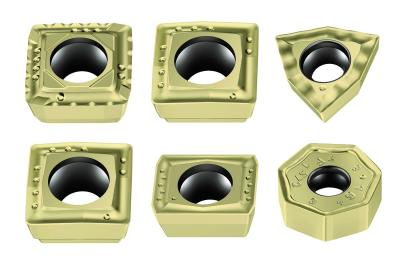
New Tiger·tec® Gold PVD grade WSP45G from Walter pushes the boundaries of what a cutting tool material can be expected to do, both in terms of applications and with respect to the materials it can efficiently process. In addition to the compatibility of WSP45G inserts with all standard milling cutters in the Walter lineup, including Xtra·tec® XT, Walter BLAXX and M4000 milling cutters. Further the new Tiger·tec® Gold PVD indexable inserts can also be used in Walter indexable insert drills such as the D4120 for ISO P steels, but also for difficult-to-cut materials from the ISO S and M material groups.
The unique TiAlN-Al2O3 multilayer coating system makes the WSP45G both hard and tough, and thus extremely resistant to abrasive wear and high temperatures, with controlled residual stresses and less flank wear, all boosting tool life. A special mechanical post-treatment improves hairline crack performance and protects the cutting edge from micro-spalling. The light gold-colored topcoat of the multilayer system makes it easier to detect wear and thereby improves process reliability. Unused cutting edges are reliably identified, making it possible to utilize the full potential of the indexable insert and further extending tool life.
Fields of application for the new Tiger·tec® Gold PVD grade include demanding machining tasks, such as materials with difficult cutting properties and interrupted cuts. Depending on the material and application, the new Tiger-tec® Gold PVD grade achieves performance improvements of up to 75 percent. In areas of use such as automotive, energy and aerospace industries, the WSP45G grade is an ideal problem solver.
Contact Details
Related Glossary Terms
- abrasive
abrasive
Substance used for grinding, honing, lapping, superfinishing and polishing. Examples include garnet, emery, corundum, silicon carbide, cubic boron nitride and diamond in various grit sizes.
- flank wear
flank wear
Reduction in clearance on the tool’s flank caused by contact with the workpiece. Ultimately causes tool failure.
- gang cutting ( milling)
gang cutting ( milling)
Machining with several cutters mounted on a single arbor, generally for simultaneous cutting.
- indexable insert
indexable insert
Replaceable tool that clamps into a tool body, drill, mill or other cutter body designed to accommodate inserts. Most inserts are made of cemented carbide. Often they are coated with a hard material. Other insert materials are ceramic, cermet, polycrystalline cubic boron nitride and polycrystalline diamond. The insert is used until dull, then indexed, or turned, to expose a fresh cutting edge. When the entire insert is dull, it is usually discarded. Some inserts can be resharpened.
- milling
milling
Machining operation in which metal or other material is removed by applying power to a rotating cutter. In vertical milling, the cutting tool is mounted vertically on the spindle. In horizontal milling, the cutting tool is mounted horizontally, either directly on the spindle or on an arbor. Horizontal milling is further broken down into conventional milling, where the cutter rotates opposite the direction of feed, or “up” into the workpiece; and climb milling, where the cutter rotates in the direction of feed, or “down” into the workpiece. Milling operations include plane or surface milling, endmilling, facemilling, angle milling, form milling and profiling.
- physical vapor deposition ( PVD)
physical vapor deposition ( PVD)
Tool-coating process performed at low temperature (500° C), compared to chemical vapor deposition (1,000° C). Employs electric field to generate necessary heat for depositing coating on a tool’s surface. See CVD, chemical vapor deposition.

